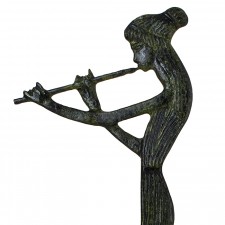Ορειχάλκινη γυναίκα που παίζει αυλό
Ορειχάλκινη γυναίκα που παίζει αυλό.
Χειροποίητο ορειχάλκινο γλυπτό, με εγγύηση ποιότητας. Παραδοσιακά φτιαγμένο με τη μέθοδο χύτευσης μετάλλου και με οξείδωση παρόμοια με του μουσείου.
Ο αυλός ήταν πνευστό μουσικό όργανο της Ελληνικής αρχαιότητας. Ανάλογα με την κατασκευή του ονομαζόταν μόναυλος (μονός αυλός), πλαγίαυλος (αυλός που παίζεται πλάγια όπως το σύγχρονο φλάουτο), δίαυλος (διπλός αυλός).
Ο αυλός ήταν βασικό όργανο σε όλους τους εορτασμούς στην Αρχαία Ελλάδα ιδιαίτερα δε σε τελετές προς τιμήν του Διονύσου. Σε παραστάσεις σε αγγεία συχνά φαίνεται ότι ο αυλός στερεωνόταν με μια δερμάτινη λωρίδα η οποία περνούσε γύρω από το κεφάλι και είχε άνοιγμα στην περιοχή των χειλιών. Οι αυλοί συχνά είχαν γλωττίδα.
Επίσης ο αυλός εμφανίζεται ως συνοδευτικό όργανα στις κινήσεις των αθλητών στις αθλητικές διοργανώσεις.Οι ηλικίες των αυλητών ποικίλουν. Συναντούμε νέους αγένειους αυλητές, αλλά και ώριμους γενειοφόρους, όμως σε καμία περίπτωση ηλικιωμένους. Στους επίσημους αγώνες αθλημάτων, κάποιοι αυλητές εμφανίζονται να συνοδεύουν στεφανωμένοι, στοιχείο που υποδηλώνει μια πιθανή διάκρισή τους σε αγώνα αυλητικής που προηγήθηκε στα πλαίσια της Διοργάνωσης
Ο αυλός είχε εμφανιστεί σε πολλές χώρες (Κίνα, Ινδία, Αίγυπτος, Ασσυρία και Βαβυλώνα, Ισραήλ). Στην Κίνα υπήρχε το σενγκ, είδος μικρού οργάνου με 12 ή περισσότερους αυλούς, γνωστό από την 3η χιλιετία π.Χ. και διάφοροι άλλοι τύποι αυλών, άλλοτε χωρίς και άλλοτε με μονή ή διπλή γλωσσίδα (είδη δηλαδή φλάουτου, κλαρινέτου και όμποε). Στην Αίγυπτο ο αυλός, γνωστός από την 5η χιλιετία π.Χ., ήταν από καλάμι, ελεφαντόδοντο, μπρούντζο ή ξύλο. Στο Ισραήλ χρησιμοποιούνταν ο αυλός του Πάνα, ποιμενικό κυρίως όργανο με επτά ή εννιά απλούς αυλούς, που ο καθένας έδινε ένα μόνο φθόγγο. Τέλος, στην Αρχαία Ελλάδα, οι αυλοί είχαν διάφορα μεγέθη (για παιδιά, εφήβους, γυναίκες ή άνδρες), ήταν κυλινδρικοί ή κωνικοί και κατασκευάζονταν από καλάμι, ξύλο ή διάφορα μέταλλα. Χρησιμοποιούνταν, επίσης, ο αυλός του Πάνα.
Στη νεότερη εποχή η χρήση του αυλού αντικαταστάθηκε από διάφορα πνευστά μουσικά όργανα, όπως το φλάουτο, το κλαρινέτο και το όμποε, καθώς και τους διαφόρους υποτύπους αυτών. Ο όρος αυλός χρησιμοποιείται πλέον σχεδόν αποκλειστικά στα πλαίσια της κατασκευής του εκκλησιαστικού οργάνου, όπου οι διάφοροι τύποι αυλών που χρησιμοποιούνται ταξινομούνται κατά υλικό κατασκευής, λειτουργίας κλπ.
Διαβάστε περισσότερα εδώ
| Λεπτομέρειες | |
| Ύψος | 15cm |
| Βάρος | 100g |
| Υλικό | Ορειχάλκινο |



